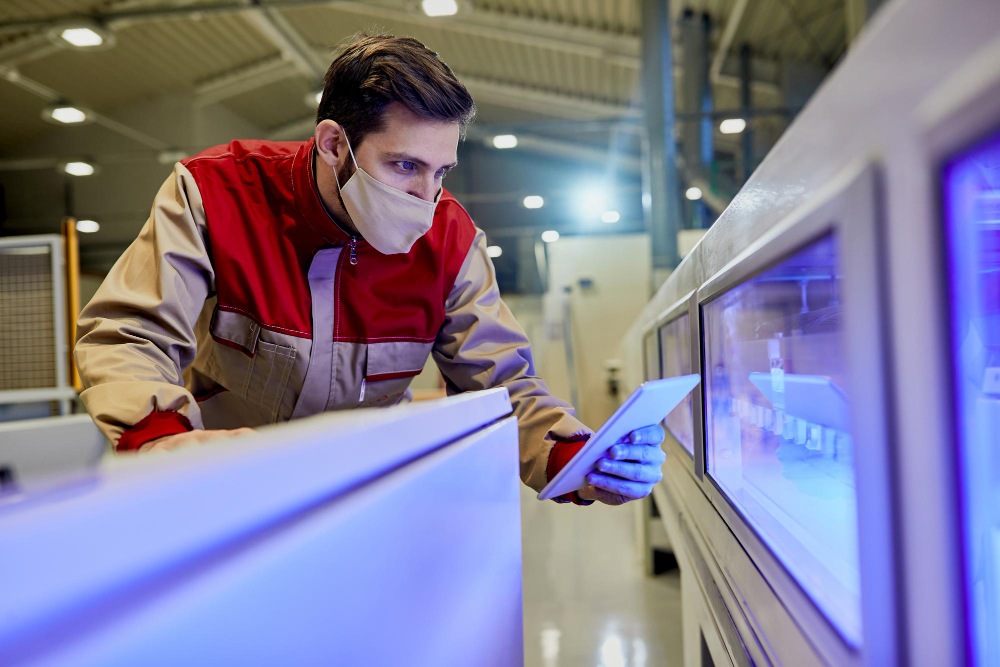From Manual Checks to Machine Vision: The Evolution of Inspection Technology

In the relentless pursuit of manufacturing perfection, one process has always stood as the critical gatekeeper: inspection. The ability to distinguish a good product from a bad one is the cornerstone of quality control, customer satisfaction, and brand reputation. But the way we perform this inspection has undergone a profound, multi-stage evolution.
We have journeyed from the simple “manual check” of an artisan’s eye to the intelligent, AI-powered systems of today. This is not just a story of technology; it’s a story of data, speed, and the redefinition of “perfection.” In an era of zero-defect tolerance and high-speed automation, this evolution is what separates market leaders from the rest.
This article traces the path from the fallible human eye to the predictive power of modern Automated Visual Inspection, a transformation enabled by cloud partners like Opsio Cloud.
Chapter 1: The Era of Manual Inspection
For centuries, quality control was an art, not a science. It relied on the skilled eye, steady hand, and sharp judgment of a human inspector. These artisans would visually scan, touch, and measure products, comparing them against a mental “golden standard.”
The Pros: In its time, this method was highly flexible. A human inspector could easily adapt to new products and could understand complex, subjective flaws that were difficult to describe, such as “poor finish” or “slight discoloration.”
The Inevitable Flaws: This model collapsed under the pressure of mass production. Its limitations became critical liabilities:
- Subjectivity & Inconsistency: The most significant flaw. An item flagged as “defective” by an inspector on Monday might be passed by a different inspector on Tuesday. Quality was inconsistent.
- The Fatigue Factor: Human concentration is finite. An inspector who is 99% accurate in their first hour may be only 80% accurate by their seventh. In a 24/7 production environment, this is a recipe for failure.
- The Speed Bottleneck: A human can only inspect so fast. As production lines accelerated to hundreds or thousands of units per hour, manufacturers had to resort to “statistical sampling”—inspecting maybe 1 in 100 products and hoping it represented the whole batch.
- The Limits of Perception: The human eye, even when aided, cannot reliably see microscopic fractures, sub-millimeter misalignments, or subtle defects in complex microelectronics.
Chapter 2: The First Leap – Traditional Machine Vision
By the 1980s and 1990s, the “manual check” was no longer viable. The first technological solution was traditional machine vision. These systems were a major leap forward, replacing the human eye with a camera and the human brain with a basic computer processor.
These systems operated on a “rule-based” or “template-matching” algorithm. An engineer would take a “perfect” image (a template) and draw boxes on it, telling the computer: “The pixels in this exact box must be black,” or “The edge of this part must be at this precise X-Y coordinate.”
The Pros: This solved two of the biggest manual-check problems: speed and consistency. The machine could run 24/7 without fatigue and inspect hundreds of parts per minute, applying the exact same rigid rules every single time.
The New Set of Flaws: This rigidity was also its greatest weakness.
- Incredibly Brittle: These systems were not “smart.” They were “programmed.” If the ambient lighting in the factory changed, or a product was rotated by half a degree, the system would fail. It couldn’t tell the difference between a harmless reflection and a critical crack.
- High False Positives: Because they were so rigid, these systems would constantly reject “good” products that had minor, acceptable variations (like a slight change in surface texture). This created a new kind of waste.
- Failed at Complexity: They were useless for inspecting anything without simple, defined edges. They could not inspect organic shapes, natural textures (like wood or fabric), or complex assemblies.
Chapter 3: The Revolution – AI-Powered Machine Vision
The last decade has seen the most significant leap of all: the infusion of Artificial Intelligence. This is the difference between a “programmed” system and a “trained” one.
Modern Automated Visual Inspection systems are powered by deep learning and neural networks. Instead of an engineer writing thousands of lines of “if-then” rules, you train the AI model, much like you’d train a new inspector. You feed the system thousands of images, showing it examples of “good” products and “bad” products.
The AI model learns on its own to identify the complex patterns, textures, and subtle anomalies that constitute a defect. It learns the difference between a harmless shadow and a hairline fracture.
This single change solves the flaws of both previous eras:
- It Has Human-like Nuance: Like a human, it can handle ambiguity and complexity. It can inspect textured surfaces, identify subtle cosmetic flaws, and understand what “good” looks like, even with minor variations.
- It Has Machine-like Consistency: Like a machine, it never gets tired, never changes its “opinion,” and operates 24/7 at full line speed. It provides the nuance of an artisan with the endurance of a robot.
- It Reduces False Positives: Because it understands the product, it dramatically reduces the number of good parts that are incorrectly rejected.
Chapter 4: The Enabler – The Cloud and Modern Infrastructure
This AI revolution didn’t happen in a vacuum. These powerful deep-learning models require immense computational power for training—power that is impractical and cost-prohibitive to maintain on-premise.
This is where the cloud becomes the essential enabler. A cloud-native platform, like that provided by Opsio Cloud, is the “brain” behind the “eye.”
By leveraging the cloud, manufacturers can:
- Scale On-Demand: Train complex AI models using massive, scalable computing power without buying a single new server.
- Centralise Intelligence: Train a single “master” AI model in the cloud and deploy it instantly across a dozen factories worldwide. This ensures every single production line is operating on the exact same quality standard.
- Manage Data: AVI systems generate a massive amount of image data. A cloud partner like Opsio Cloud manages this data flow, making it accessible for analysis and retraining.
This infrastructure is what makes Automated Visual Inspection Services a practical, scalable, and affordable reality for manufacturers today.
Conclusion: The Future is Intelligent Inspection
The evolution of inspection technology has brought us to an exciting new era. We’ve moved from the slow, subjective “manual check” to the rigid “rule-based” machine, and finally to the “intelligent” AI-powered system.
Today, Automated Visual Inspection Services are no longer just about finding defects (a reactive process). They are about preventing them. The data generated by these smart systems feeds back into the manufacturing process, creating an intelligent loop. The system doesn’t just say “this part failed”; it says “80% of failures are this specific defect,” allowing engineers to find and fix the root cause immediately.
This is the foundation of the modern “smart factory.” To compete, manufacturers must embrace this evolution.



